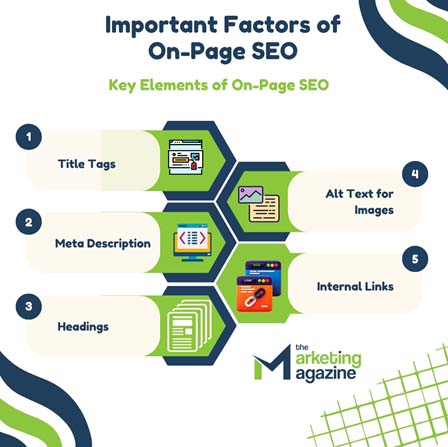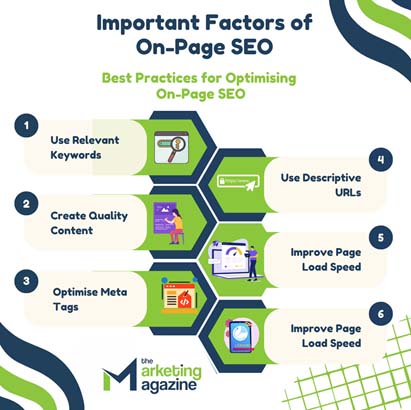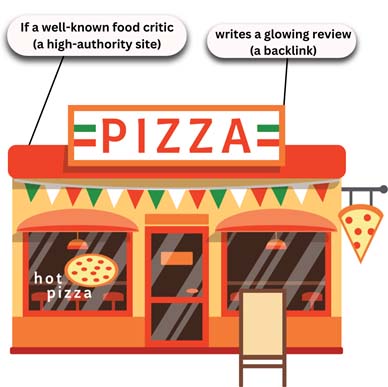Introduction
On-Page and Off-Page SEO are two crucial aspects of optimizing a website for search engines. On-Page SEO involves optimizing elements on your website, such as content, HTML tags, and site structure. It includes practices like using relevant keywords, creating high-quality content, optimizing meta tags, use responsive as well and good user experience design.
Off-Page SEO, on the other hand, focuses on actions taken outside your website to improve its authority and ranking. This includes building backlinks from other reputable websites, social media marketing, and online reputation management.

Think of your website as a new restaurant. On-Page SEO is like making sure your restaurant has a great menu, appealing decor, and excellent service. Off-Page SEO is like getting positive reviews and recommendations from food critics and customers who spread the word about your restaurant.
For example, if you run a blog about cooking, On-Page SEO would be using keywords like “easy recipes” in your posts, while Off-Page SEO would involve other food bloggers linking to your blog. By combining both strategies, you make your site more attractive to search engines and users alike, just like a well-reviewed restaurant attracts more diners.
The importance of On-Page SEO
On-Page SEO is crucial because it helps search engines understand your website’s content and determine if it’s relevant to users’ search queries. Good on-page SEO can significantly improve your website’s visibility, leading to higher rankings in search results and more organic traffic. It’s like setting up a shop where everything is well-organised and easy to find, making it attractive to both visitors and search engines.
Key Elements of On-Page SEO
Several key elements contribute to effective on-page SEO. These include:

– Title Tags: The main heading of a page that tells search engines and users what the page is about.
– Meta Description: Brief summaries of a page’s content, which appear under the title in search results.
– Headings (H1 To H6 ): These organise the content and make it easier for users to read.
– URL Structure: Clean and descriptive URLs help search engines understand the page’s content.
– Alt Text for Images: Descriptive text for images helps search engines understand what the images are about.
– Internal Links: Links to other pages on your website that help keep users engaged and spread link equity.
Best Practices for Optimising On-Page SEO
To optimise on-page SEO, follow these best practices:

- Use Relevant Keywords: Integrate relevant keywords naturally into your content, title tags, and headings.
- Create Quality Content: Write informative, engaging, and valuable content for your audience.
- Optimise Meta Tags: Write compelling meta descriptions and use relevant keywords in your title tags.
- Use Descriptive URLs: Create short, keyword-rich URLs that clearly describe the page content.
- Improve Page Load Speed: Ensure your pages load quickly, as slow-loading pages can hurt your rankings.
- Make Your Site Mobile-Friendly: Ensure your website is responsive and works well on all devices.
Imagine your website is like a well-organised library. On-Page SEO is about putting clear labels on the books (title tags), providing summaries on the cover (meta descriptions), and arranging them in a logical order (headings and URLs). This way, both visitors and librarians (search engines) can easily find what they’re looking for.

The importance of Off-page SEO
Off-page SEO refers to actions taken outside of your own website to improve its ranking on search engine results pages (SERPs). Unlike on-page SEO, which focuses on optimising elements within your website, off-page SEO aims to enhance your website’s authority and reputation. This is primarily achieved through link building, social media marketing, and influencer outreach.
Key off-page SEO techniques include:
- Link Building: Acquiring high-quality backlinks from reputable websites to increase your site’s credibility.
- Social Media Marketing: Sharing content on social media platforms to drive traffic and engagement.
- Influencer Outreach: Partnering with influencers to promote your content and generate backlinks.
Building High-Quality Backlinks
Building high-quality backlinks is crucial for off-page SEO. Backlinks are like votes of confidence from other websites. The more reputable the linking site, the more valuable the backlink.

Example: Imagine your website is a new pizza place in town. If a well-known food critic (a high-authority site) writes a glowing review (a backlink) about your pizza, more people will trust and visit your place. Similarly, quality backlinks from respected websites signal to search engines that your site is trustworthy and relevant, boosting your SEO performance.
Tools and resources used
Effective SEO management requires the right tools and resources to optimise both on-page and off-page elements. Using these tools can help you monitor your website’s performance, identify areas for improvement, and implement strategies that boost your search engine rankings.
Recommended SEO Tools for On-Page Optimization
For on-page SEO, tools like Yoast SEO and SEMrush are invaluable. Yoast SEO helps you optimise your content by providing real-time feedback on readability, keyword usage, and meta descriptions. It’s like having a grammar coach for your website. SEMrush offers comprehensive site audits, keyword research, and insights into how your content compares with competitors. Think of it as a detective kit that uncovers the strengths and weaknesses of your website.
Top Tools for Off-Page SEO Success
Off-page SEO focuses on activities outside your website to improve its authority and ranking. Ahrefs and Moz Link Explorer are popular tools for this. Ahrefs allows you to analyse your backlink profile, find link-building opportunities, and monitor your competitors’ backlinks. It’s like having a spyglass to see where your competitors are getting their strength. Moz Link Explorer helps track your domain authority and discover new link-building prospects. Imagine it as a treasure map guiding you to valuable backlinks.
Example: Imagine you’re baking a cake. On-page SEO tools like Yoast SEO are your recipe, ensuring you have the right ingredients (keywords) and follow the steps correctly (readability and meta descriptions). Off-page SEO tools like Ahrefs are like your friends sharing your cake recipe with others, helping spread the word about how great your cake (website) is. Combining both ensures your cake is not only delicious but also known by everyone!
These tools streamline SEO management, making the process more efficient and effective.
What are the common challenges and how do you overcome them?
SEO (Search Engine Optimization) is essential for improving your website’s visibility, but it comes with its own set of challenges. Understanding and overcoming these challenges can significantly enhance your SEO efforts.
On-Page SEO mistakes to avoid
One common on-page SEO pitfall is keyword stuffing, where you cram too many keywords into your content, making it unnatural and hard to read. Another issue is neglecting meta descriptions and title tags, which are crucial for search engines to understand your page content. To avoid these pitfalls, focus on writing high-quality, relevant content with a natural use of keywords, and always optimise your meta tags.
Off-Page SEO Mistakes and Solutions
In off-page SEO, a common mistake is acquiring low-quality backlinks. These can harm your website’s reputation and ranking. Another mistake is ignoring social media engagement, which can boost your site’s visibility and traffic. To overcome these issues, focus on earning high-quality backlinks from reputable sites and actively engage with your audience on social media platforms.
Let’s understand this topic using an example.Imagine your website is like a pizza restaurant. On-page SEO is like making sure your pizzas are delicious, with the right amount of toppings (keywords) and a great menu (meta tags) that customers (search engines) find attractive. Off-page SEO is like getting good reviews and recommendations (backlinks) from food critics and customers. If you stuff your pizza with too many toppings, it becomes unappetizing, and if you get bad reviews from shady sources, it can hurt your restaurant’s reputation. Balancing both ensures your restaurant (website) attracts more happy customers (visitors).
Real life case studies
In the world of SEO, combining on-page and off-page strategies can lead to remarkable results. Let’s look at a few successful examples to understand how this synergy works.
Real-World Examples
One great example is the online shoe retailer Zappos. They focused on detailed product descriptions (on-page SEO) while also gaining high-quality backlinks from fashion blogs and industry sites (off-page SEO). This dual approach helped them rank higher on search engines, driving more traffic to their site.
Another example is Neil Patel’s website, which offers digital marketing advice. Neil ensures his articles are well-optimised with relevant keywords and engaging content (on-page SEO). Simultaneously, he builds a strong backlink profile by guest posting on reputable websites and engaging with industry influencers (off-page SEO). This combination has made his website a go-to resource in the marketing world.
Key Takeaways from Successful Campaigns
The key to success is balancing on-page and off-page efforts. Focus on creating high-quality, relevant content and optimising it with the right keywords. At the same time, work on building relationships with other websites and gaining backlinks.
Future trends
As search engines evolve, so do SEO techniques. Future trends in SEO will focus heavily on user experience and advanced technologies like artificial intelligence (AI) and machine learning. Search engines are getting better at understanding user intent and providing personalised search results. This means SEO strategies will need to adapt to these changes to stay relevant.
Emerging On-Page SEO Techniques
Emerging on-page SEO techniques emphasise creating high-quality, engaging content that satisfies user intent. This includes optimising for voice search, which is becoming increasingly popular. Think about how people use voice assistants like Siri or Alexa to find information. Your content should be structured to answer these spoken queries directly. Additionally, focusing on mobile optimization and fast page load times is crucial as more users access the internet via mobile devices.
The Evolution of Off-Page SEO Practices
Off-page SEO is evolving to prioritise building genuine relationships and trust. This means acquiring high-quality backlinks from reputable sources and engaging in social media to drive traffic. Social signals, like shares and likes, are becoming more significant as they indicate your content’s value and relevance.
By staying updated with these emerging trends and evolving practices, you can ensure your SEO strategy remains effective and keeps your site visible and engaging to users.
Conclusion
In conclusion, integrating on-page and off-page SEO strategies is crucial for achieving optimal results in search engine optimization. By focusing on both aspects, businesses can enhance their website’s visibility and attract more organic traffic.
Key points highlighted include the importance of optimizing on-page elements like content, meta tags, and site structure to improve user experience and search engine rankings. Simultaneously, off-page efforts such as building quality backlinks and enhancing online reputation play a vital role in establishing authority and credibility.
For effective SEO integration, businesses should regularly monitor and analyze performance metrics, adjust strategies based on data insights, and stay updated with industry trends. By maintaining a balanced approach and adapting to changes, businesses can maximize their SEO efforts and drive sustainable growth in online presence and visibility.